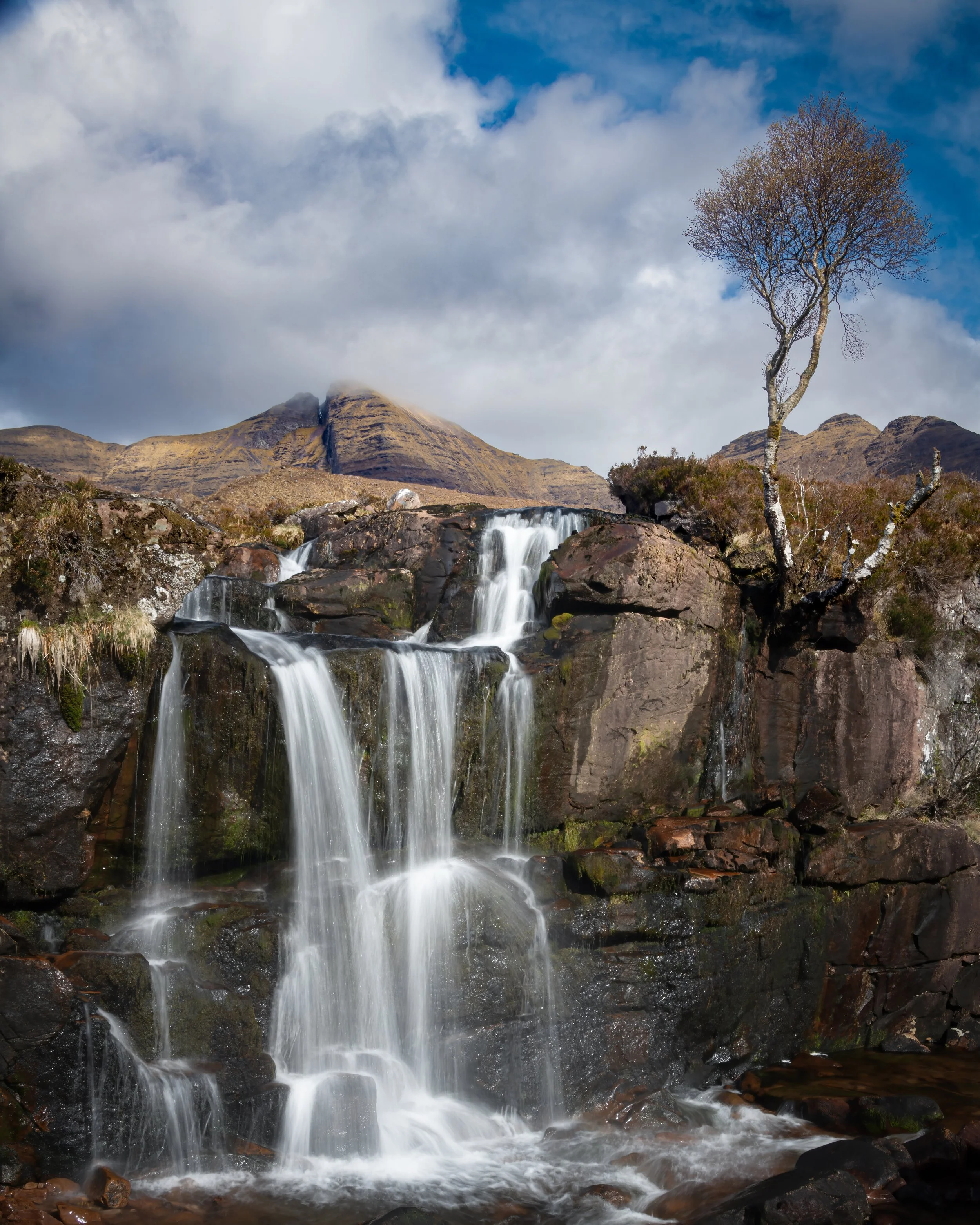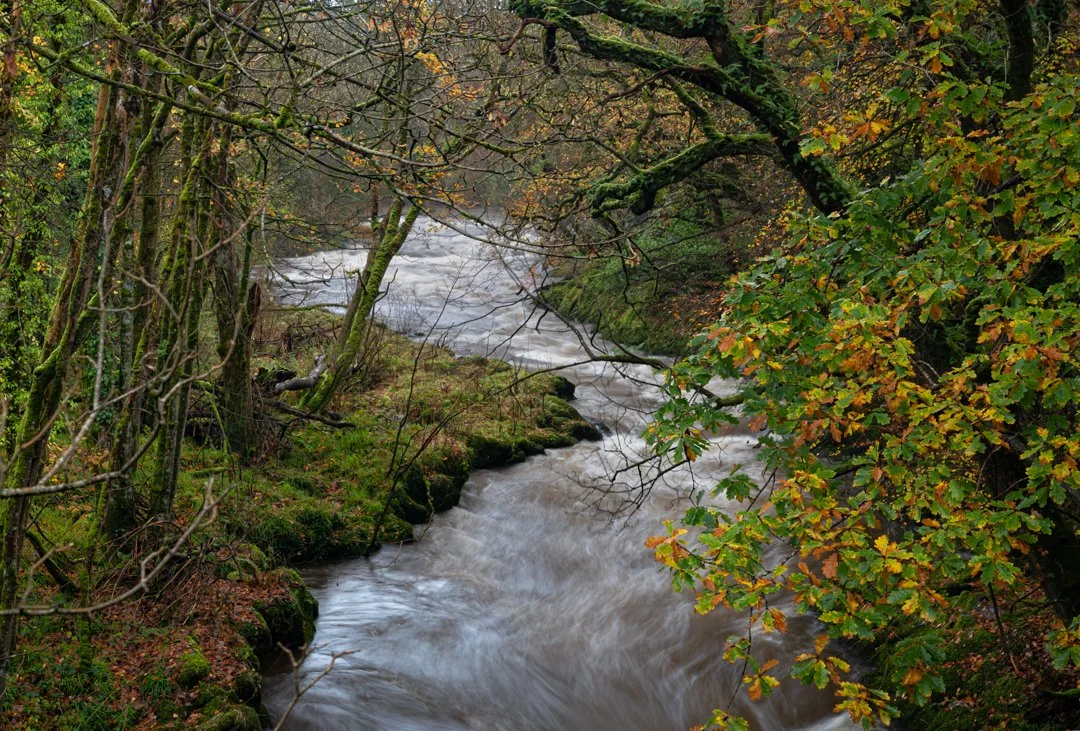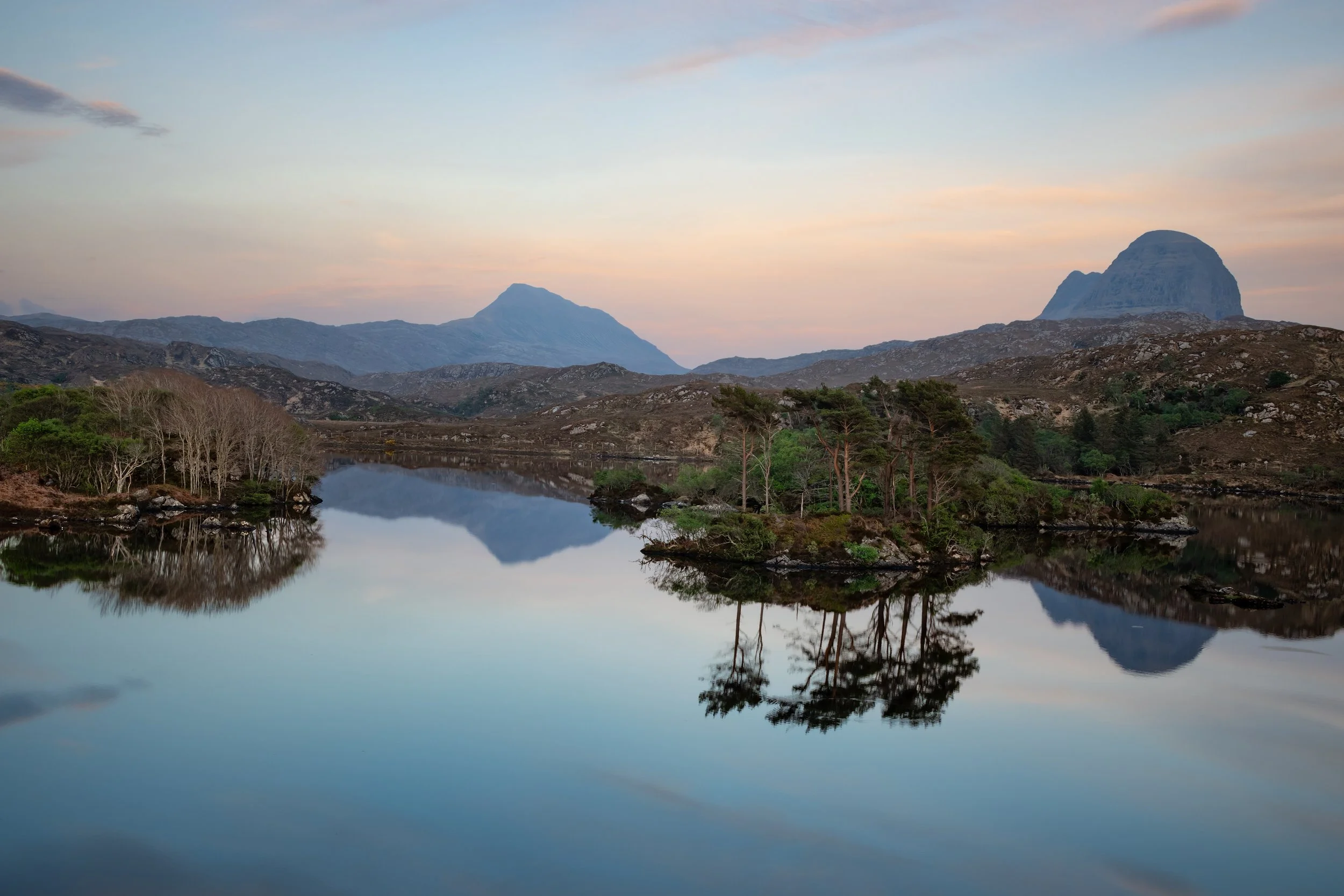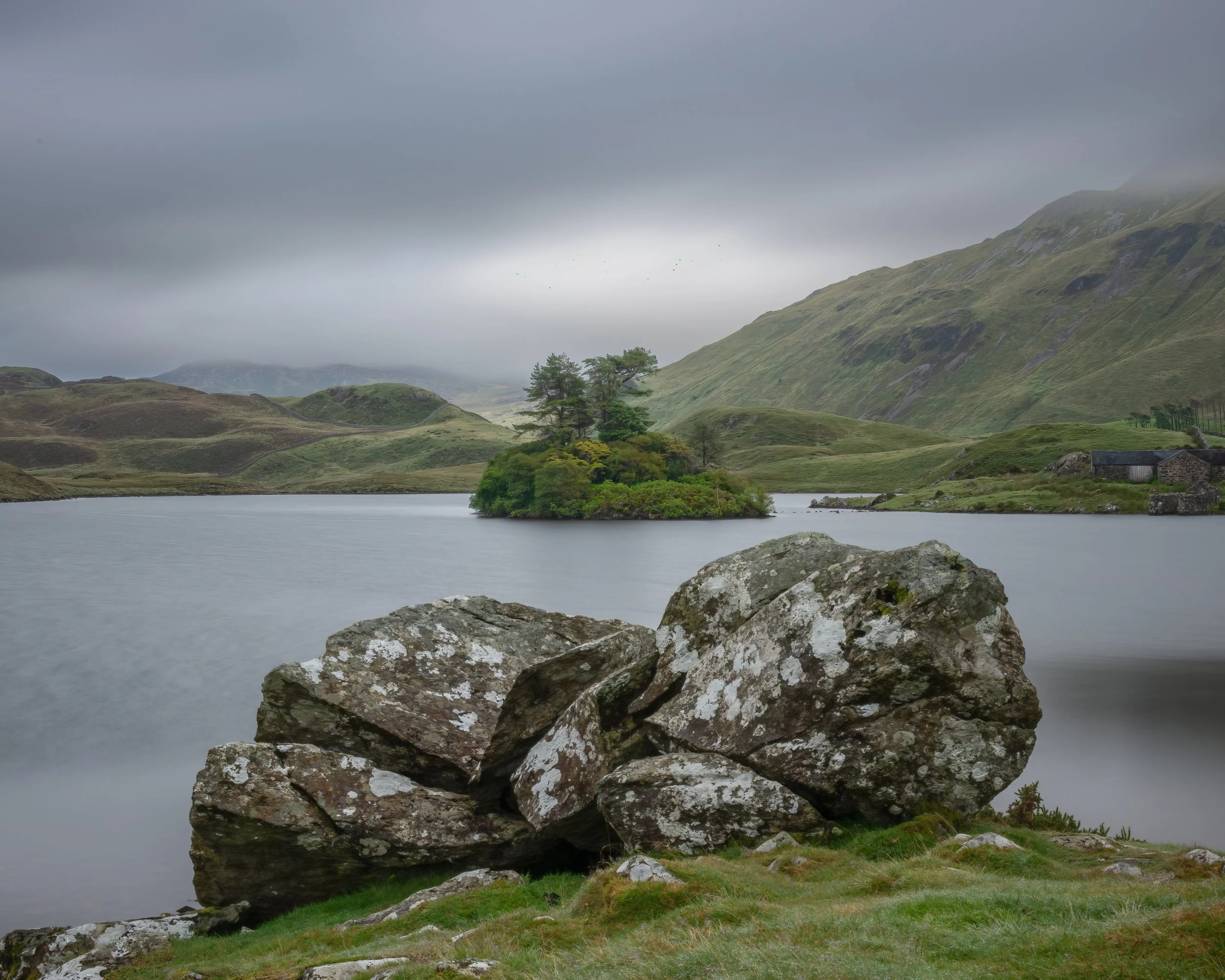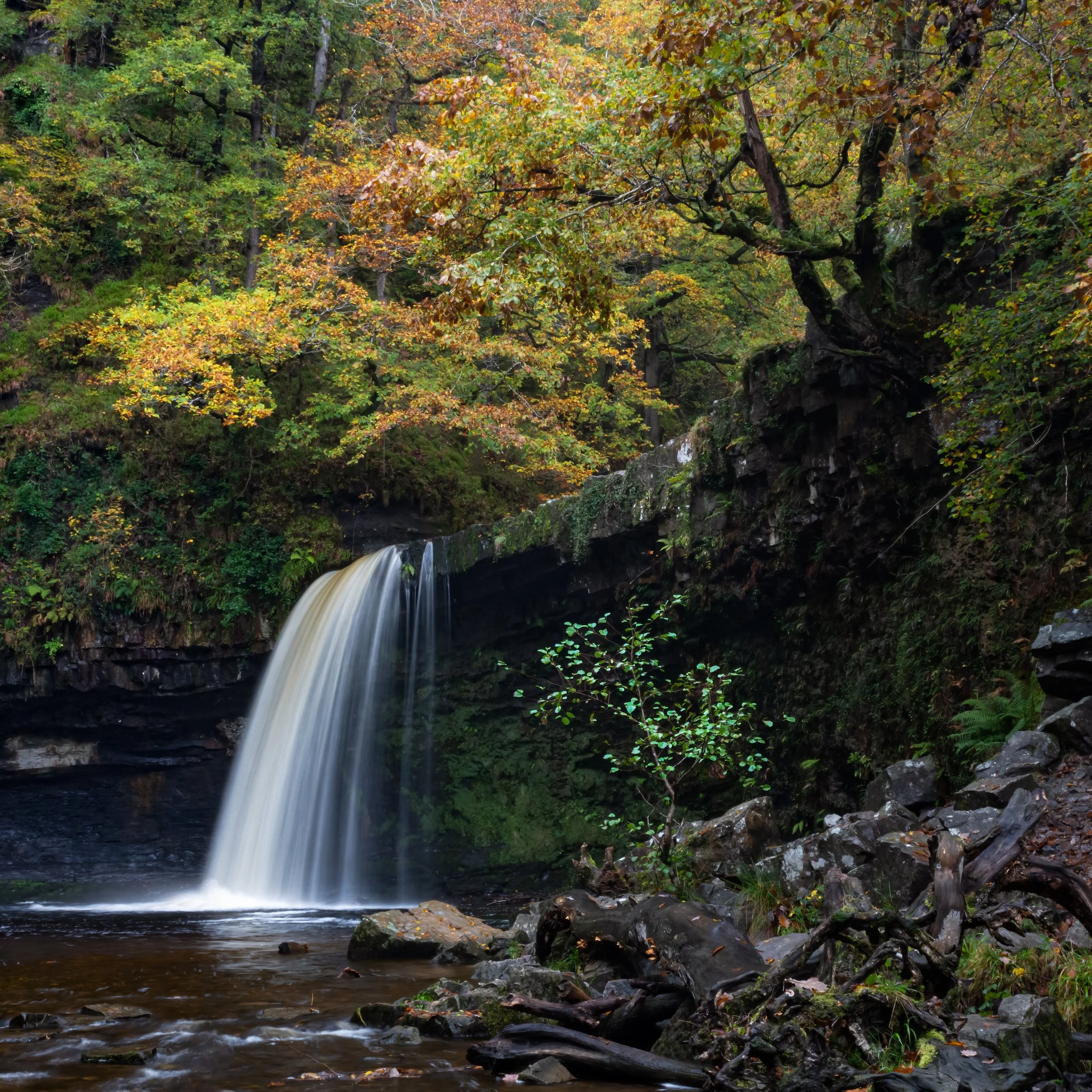RIVERS - WATERFALLS - LAKES
“And a music rang where the rivers run”
Dolgoch Falls, near to the base of Cader Idris in Southern Eryri. I made several photos of this splendid cascade, filling up the space with the falls; but looking back whilst climbing up through the wood, I realized that this view, from afar, would be my favourite: the golden glow from the back of the woods, the leaning branches, the moss and overhanging growth, all embracing the pure jewel of the falls with its double cascade. To me this jad the right form to tell the story I wanted to tell.
I love Cwm Bychan, in southern Eryri, overlooked by the Rhinog mountains. Autumn is a special time here. This photograph features fast moving water, the colours of early autumn, and a splendid ancient tree with beautifully shaped branches overlooking the stream, as if keeping the stream in its embrace. I wanted to convey the rushing water and an intimate feeling of mystery.
In the Brecon Beacons of Wales is a truly magical area, full of spectacular waterfalls and mysterious woodlands. Most English speakers refer to this area with the very prosaic name “Waterfall Country”, but its name is Ystradfellte, a name the pronunciation of which can defeat those without a knowledge of Welsh. For the record, though, Welsh pronunciation is actually relatively easy once a few simple rules are learned - it is absolutely consistent to those rules! This particular cascade is called Sgwd Clun Gwyn Isaf (Sgwd means waterfall, Isaf means lower, Gwyn means white, clun means hip or buttock) and the name is therefore: “Lower White Buttocks Waterfall”. While we’re at it the pronunciation is roughly “s’good clean Gwyn Isav”. There we are then, that should whet the appetite for more Cymraeg!
To get this image I had to cross the fast moving stream with extremely slippery rocks under foot - fortunately I was wearing waders, but falling in was not an option with my camera and tripod in hand. I needed to get the symmetry of the divided stream and the tall cascade in the middle of the image, which meant crossing the stream. I could feel a number of eyes scrutinizing my every move and waiting for me to take a tumble, so I wasn’t going to look up. But all was good, and I loved the feeling of a naturally carved amphitheatre in front of the main falls. Technically this is a hard shot, because there are very dark areas of the picture where it is easy to lose all detail, and yet the white water is bright (image has a particularly wide dynamic range). I decided to go for around a 1/4 second exposure, to keep detail in the running water which expressed a sense of motion - any longer and the water starts to look like a mushy blanc-mange. There was quite a bit of editing to do later in order to retain details in both the darker and lighter areas of the image.
I had for more than forty years harboured an ambition to visit the islands in that most beautiful of Scottish lochs, Loch Maree. These islands contain a residue of ancient Caledonian forest in the form of Scots Pines and other unique fauna and flora. I’d wanted to see these at close quarters, as well as the chance to look at the local mountains from a new angle. I realised that hiring a kayak and rowing across was a little beyond my pay grade, as the loch is one of the largest in Scotland and when the wind whips up it can get quite rough and hard for a novice to control; in addition to which I could not risk capsizing and destroying all my camera gear. I therefore hired the services of a professional who would operate a two-man kayak. This was a great choice, as I could choose where to go, but informed by someone who could ensure both safety but also could give suggestions informed by local knowledge. There were many photographic opportunities on this trip. I have chosen this image as it features a group of Scots Pines on one of the islands, as well as the beautiful reflections on the blue water; I wanted the viewer to get the sense that they themselves were on the water. For the image I chose a square format, and obviously, being in a boat which cannot keep still, a long exposure is not an option; fortunately it wasn’t something I’d wanted for this particular photo, as the textures on the water were very much a part of the image.
Anyone who has visited Torridon will recognize the large gash “Eag Dhubh/Black cleft” on Beinn Alligin. I wanted to photograph these falls with Eag Dhubh forming the background. To get the right angle to show off the waterfall I had to climb about half way down the gorge opposite, and wanted the bottom of the falls to be visible at the base of the image: a little tricky as the gorge was steep, wet and slippery. Dark clouds and sunshine were the order of the day, and I had quite a wait for the conditions to be exactly right for the image. I wanted there to be sunshine at the top of the falls, but not too glaring, and I wanted sunlight also on the mountain, preferably with a little cloud on the top, but not enough to obscure it. I was rewarded eventually! I like the tree at the edge of the falls - in my imagination it’s standing there as the guardian of the falls. To frame the mountain there needed to be just enough sky for the image not to seem cramped. Quite a lot to get in to one shot, but I hope the photo works elegantly as a whole.
In around 2022 there was a very cold spell one winter, where temperatures reached -14°. The nearby Cenarth Falls almost froze over. I spent a few hours here as the rocks looked so attractive with the crystalline ice, and icicles were everywhere. For viewers living in colder climes, such as sight may seem commonplace, but here in South Wales, seeing this local landmark decorated with ice crystals was an exhilirating sight. It remained to find a good composition from these elements, and one that included the moving water also. Essentially this is a monochrome image, but I decided to leave it the original blueish tinge.
I was walking far up Coire Mhic Nobuil, in the middle of the Torridon range, in April 2025; I wanted to show a friend this unique wilderness, surrounded by the area’s main mountains - Alligin, Eighe and Liathach. The track moves gradually uphill following the stream. It seemed as if at each step we took, the rain became harder and harder, and the stream was becoming fuller and fuller. Near to the limit of our walk one of the many waterfalls generated by the swollen stream caught my eye. I loved the secondary fall, a little higher than the main one, and how the water was ricocheting off a rounded rock below; I liked the darkness of the rocks, and the low clouds not much higher than we were, with a trace of Sail Mhor just visible, a peak that is part of the Beinn Eighe massif. I wanted to get as low as I could so not only to include the slopes of Sail Mor and the lowering sky, but also to give the descending water a sense of force and power. It was hard to fix the tripod on small wet stones between the boggy slope and crouch down to frame the image - a quarter of a second exposure was simply too long to get a sharp exposure hand-held; at the same time it was tricky keeping the glass dry for the shot. But I was rewarded, and this is up there with my favourite images from this trip to Torridon.
The forces of nature are very much evidenced in this photo of the waterfall at Cwm Silio, near Cwm Tydu in Ceredigion. In summer it’s not much more than a trickle, but in autumn and winter in particular it becomes a torrent very quickly. The water races down, being forced violently from side to side by the rocks, whose strata are also at a giddy angle; I love the drama created looking at these strata and at the changing directions of the water. This image is about the forces of nature. These falls are set in lovely woodland with moss-covered rocks everywhere as the water descends to the sea.
The river Teifi at Henllan, viewed from Henllan bridge. This image was taken in early autumn. The challenge was to find a place from where the many small branches potentially blocking the view of the meandering river caused minimum visual disruption: ideally some of them would not be there, but I judged that they do not distract too much. The shape of the river’s contour, the dark-edged river banks and the trees all leaning inwards to fill the space above the river, make for an attractive image with a dream-like quality. That’s the aim, anyway!
Glen Canisp lodge near Lochinver in Assynt is a favourite starting point for walkers ascending Suilven (the rounded peak on the right). Sunrise is very early in May, but I was not alone and another photographer was seizing this serene moment too, which we both shared with an army of midges that had emerged prematurely! But with a view like this that was easily ignored. Although it wasn’t the kind of sunrise where the whole sky lights up with spectacular colours, the subtle pastel tones and wisps of cloud combined with the reflections on the glass-still loch gave an atmospheric alternative. This is a panorama of two images, looking East into the Assynt wilderness.
Llynau Cregennan (Cregennan lakes), are near the Mawddach estuary in southern Eryri/Snowdonia, not far from Cadair Idris. It is hard to get a bad picture from this beautiful location, and there is no one obvious place which yields “the shot”. There are two photos here of the main lake and I have featured the wooded island in both. In this one I have placed the wonderfully textured and shaped rock in the foreground, and it makes an almost triangular shape with the island and its trees. I caught a moment when the light was brightest behind the island, helping that to become a focal point. This is a long exposure, ensuring the lake has a calm and smooth surface. The photo was taken when it was beginning to get dark, and together with the long exposure, gives off subdued and subtle lighting on the background hills. It’s all about the light!
A second image of Llynau Cregennan. This time I wanted the simplicity of the wooded island with minimal surroundings, the focus being created by virtue of it being darker than the background. I’ve tried to create a sense of magic or dreaming by slightly emphasising contrasts in both the trees and the background slopes. I wanted a square format for this monochrome image.
Llyn y Dywarchen in Eryri, with the dawn over Yr Wyddfa, or Mt. Snowdon. Llyn y Dywarchen is well-known to anglers and photographers,as well as with the general visitor, with a fantastic view over the big mountain. I had also taken some sunset pictures the previous evening, but I prefer the ethereal colours which started the next day, even though that meant a lack of sleep. The lake was for a short time completely calm and seeing the resultant reflections really gave something extra to the photo. With sunrises and sunsets you never know when the best moment will be, and the time is short, so the best thing is to keep on taking photos throughout the period, and then delete all but the best ones later at home; this avoids the “I was just waiting one extra minute for the sky to really turn, but then.. it just fizzled out… I missed it” syndrome! I think the island in the lake and the foreground elements also help this image. A bonus for me during my time at Llyn y Dywarchen was that an angler who was there during the late evening gave me the fish he had caught, as he said he liked fishing but not eating the fish. I cooked it the next day in the van, and I can say it was the most delicious fish I’ve ever eaten - we get used to farmed fish without realising!
I chanced upon this scene whilst in the Lake District, a little stream swollen by heavy rains at the perfect time during the autumn. I immediately knew this would be the aboslute perfect spot, with the little old bridge at the centre and the stream leading you through the image to the gorgeous autumn trees and Derwentwater in the far distance. At that time I didn’t know that this is quite a well-known location for photographers, and the bridge is grade 2-listed and an old packhorse bridge called Ashness Bridge. I’d just gone on a drive into the hills having visited the nearby Lodore Falls, which is what this stream turns into as it approaches Derwentwater. Looking at this picture all these years later, I think I might edit it a little differently with some discrete dodging and burning (selectively and very subtly lightening and darkening areas of the image), but I’ve decided to leave it as I originally made it, as I think it works quite well.
Sgwd Gwladys, meaning Princess Falls, part of Ystradfellte in the Brecon Beacons. I find this such an elegant falls - the overhang means that the cascade is uninterrupted and makes a beautiful curve. However, this is a hard subject to photograph well, because the rock near the falls is always very dark because of its aspect. However, the water beneath is shallow, so it is easy to get different angles on the falls by placing the tripod in the stream at different points. On this occasion I could use the dark overhang to advantage by having the brightly illuminated little sapling in front of it, which not only gave some interest to that area, but nicely complemented the cascade. I’ve tried to get balance in the image with the falls mostly on the left, and the overhang stretching all the way to the top right. The foreground rocks and the sapling are to the right, with the angle of the top of the rocks mirroring that of the overhang, and finally the sunlit autumn trees top centre but stretching to the left. The dark background is also used to advantage to highlight the brightly lit cascade. Well, it’s fine to try to rationalize a composition, but of course meaningless unless the photo actually works, a judgement I’ll leave to the viewer!




